headlamp FORD F-650/750 2022 User Guide
[x] Cancel search | Manufacturer: FORD, Model Year: 2022, Model line: F-650/750, Model: FORD F-650/750 2022Pages: 379, PDF Size: 5.29 MB
Page 104 of 379

III (start) - Cranks the engine.
STARTING A GASOLINE
ENGINE
When you start the engine, the idle speed
increases, this helps to warm up the
engine. If the engine idle speed does not
slow down, have your vehicle checked as
soon as possible.
Before starting the engine check the
following:
• Make sure all occupants fasten their
seatbelts.
• Make sure the headlamps and
electrical accessories are off.
• Make sure the parking brake is on.
• Make sure the transmission is in park
(P) or neutral (N).
• Turn the ignition key to the on position.
Note: Do not touch the accelerator pedal.
1. Fully press the brake pedal.
2. Turn the key to the start position to start the engine. Release the key when
the engine starts.
Note: The engine may continue cranking
for up to 15 seconds or until it starts.
Note: If you cannot start the engine on the
first try, wait for a short period and try again.
Failure to Start
If you cannot start the engine after three
attempts, wait 10 seconds and follow this
procedure:
1. Fully press the brake pedal.
2. Fully press the accelerator pedal and hold it there.
3. Start the engine. Stopping the Engine When Your
Vehicle is Stationary
1. Shift into park (P) or neutral (N).
2. Turn the key to the off position.
3. Apply the parking brake.
Stopping the Engine When Your
Vehicle is Moving
WARNING:
Switching off the
engine when your vehicle is still moving
results in a significant decrease in
braking assistance. Higher effort is
required to apply the brakes and to stop
your vehicle. A significant decrease in
steering assistance could also occur. The
steering does not lock, but higher effort
could be required to steer your vehicle.
When you switch the ignition off, some
electrical circuits, for example airbags,
also turn off. If you unintentionally switch
the ignition off, shift into neutral (N) and
restart the engine.
1. Switch the ignition off to stop the engine.
2. Put the transmission into neutral (N) and use the brakes to bring your vehicle
to a safe stop.
3. When your vehicle has stopped, shift into park (P).
4. Apply the parking brake.
Guarding Against Exhaust Fumes WARNING:
Exhaust leaks may
result in entry of harmful and potentially
lethal fumes into the passenger
compartment. If you smell exhaust
fumes inside your vehicle, have your
vehicle inspected immediately. Do not
drive if you smell exhaust fumes.
101
2022 F650750 (TBC) , enUSA, Edition date: 202010, Second-Printing Starting and Stopping the Engine
Page 105 of 379
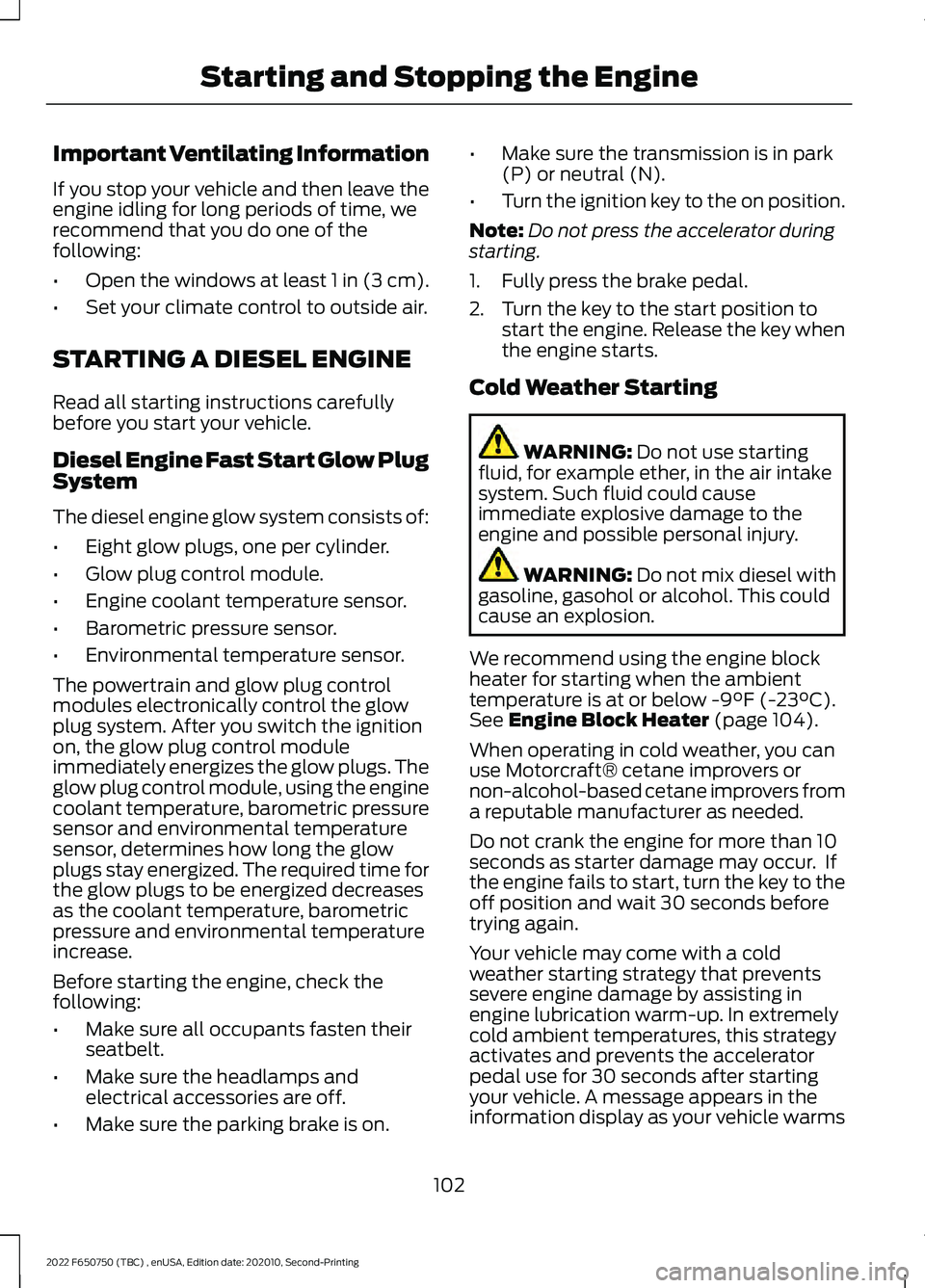
Important Ventilating Information
If you stop your vehicle and then leave the
engine idling for long periods of time, we
recommend that you do one of the
following:
•
Open the windows at least 1 in (3 cm).
• Set your climate control to outside air.
STARTING A DIESEL ENGINE
Read all starting instructions carefully
before you start your vehicle.
Diesel Engine Fast Start Glow Plug
System
The diesel engine glow system consists of:
• Eight glow plugs, one per cylinder.
• Glow plug control module.
• Engine coolant temperature sensor.
• Barometric pressure sensor.
• Environmental temperature sensor.
The powertrain and glow plug control
modules electronically control the glow
plug system. After you switch the ignition
on, the glow plug control module
immediately energizes the glow plugs. The
glow plug control module, using the engine
coolant temperature, barometric pressure
sensor and environmental temperature
sensor, determines how long the glow
plugs stay energized. The required time for
the glow plugs to be energized decreases
as the coolant temperature, barometric
pressure and environmental temperature
increase.
Before starting the engine, check the
following:
• Make sure all occupants fasten their
seatbelt.
• Make sure the headlamps and
electrical accessories are off.
• Make sure the parking brake is on. •
Make sure the transmission is in park
(P) or neutral (N).
• Turn the ignition key to the on position.
Note: Do not press the accelerator during
starting.
1. Fully press the brake pedal.
2. Turn the key to the start position to start the engine. Release the key when
the engine starts.
Cold Weather Starting WARNING: Do not use starting
fluid, for example ether, in the air intake
system. Such fluid could cause
immediate explosive damage to the
engine and possible personal injury. WARNING:
Do not mix diesel with
gasoline, gasohol or alcohol. This could
cause an explosion.
We recommend using the engine block
heater for starting when the ambient
temperature is at or below
-9°F (-23°C).
See Engine Block Heater (page 104).
When operating in cold weather, you can
use Motorcraft® cetane improvers or
non-alcohol-based cetane improvers from
a reputable manufacturer as needed.
Do not crank the engine for more than 10
seconds as starter damage may occur. If
the engine fails to start, turn the key to the
off position and wait 30 seconds before
trying again.
Your vehicle may come with a cold
weather starting strategy that prevents
severe engine damage by assisting in
engine lubrication warm-up. In extremely
cold ambient temperatures, this strategy
activates and prevents the accelerator
pedal use for 30 seconds after starting
your vehicle. A message appears in the
information display as your vehicle warms
102
2022 F650750 (TBC) , enUSA, Edition date: 202010, Second-Printing Starting and Stopping the Engine
Page 168 of 379
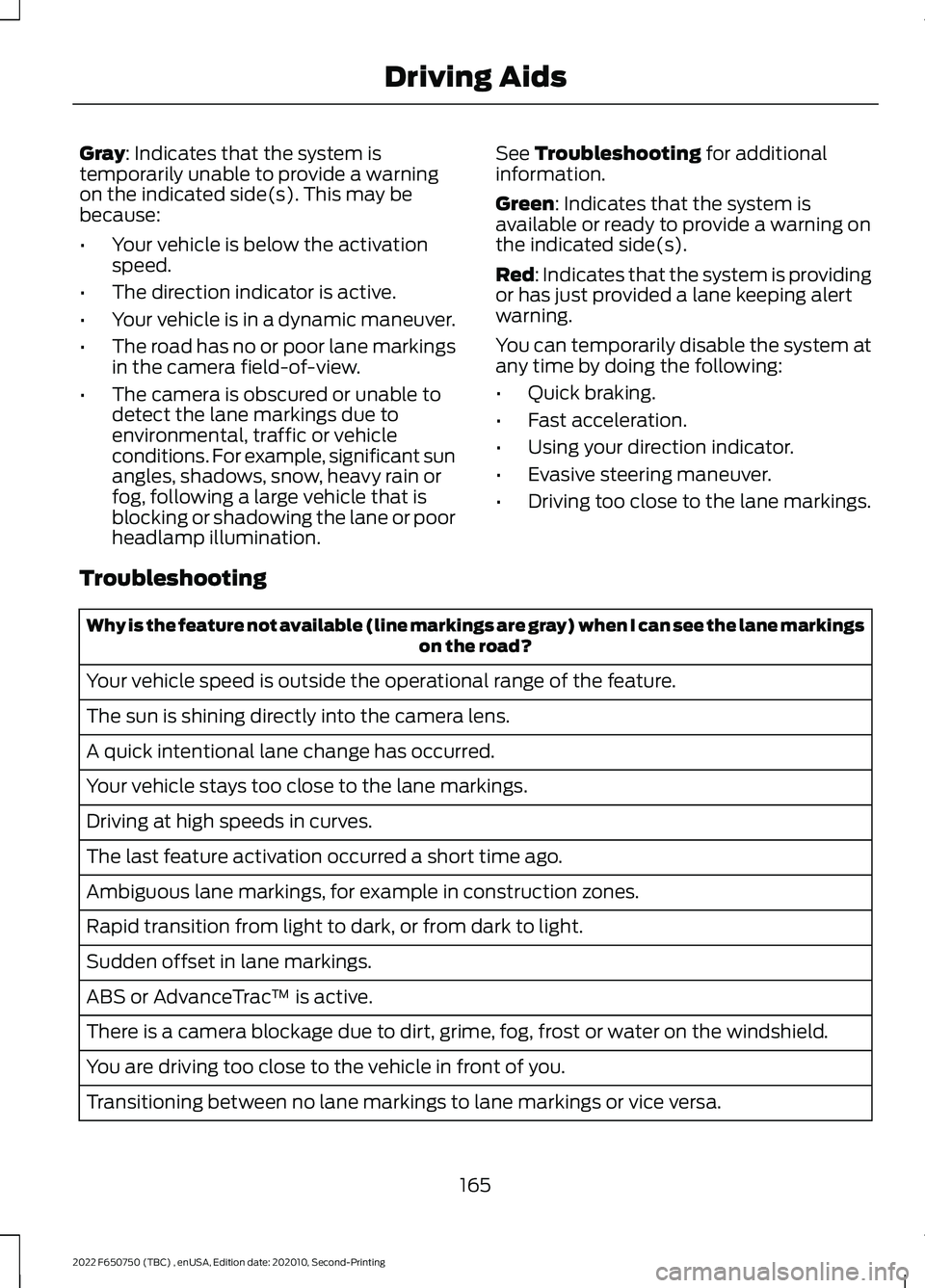
Gray: Indicates that the system is
temporarily unable to provide a warning
on the indicated side(s). This may be
because:
• Your vehicle is below the activation
speed.
• The direction indicator is active.
• Your vehicle is in a dynamic maneuver.
• The road has no or poor lane markings
in the camera field-of-view.
• The camera is obscured or unable to
detect the lane markings due to
environmental, traffic or vehicle
conditions. For example, significant sun
angles, shadows, snow, heavy rain or
fog, following a large vehicle that is
blocking or shadowing the lane or poor
headlamp illumination. See Troubleshooting for additional
information.
Green
: Indicates that the system is
available or ready to provide a warning on
the indicated side(s).
Red
: Indicates that the system is providing
or has just provided a lane keeping alert
warning.
You can temporarily disable the system at
any time by doing the following:
• Quick braking.
• Fast acceleration.
• Using your direction indicator.
• Evasive steering maneuver.
• Driving too close to the lane markings.
Troubleshooting Why is the feature not available (line markings are gray) when I can see the lane markings
on the road?
Your vehicle speed is outside the operational range of the feature.
The sun is shining directly into the camera lens.
A quick intentional lane change has occurred.
Your vehicle stays too close to the lane markings.
Driving at high speeds in curves.
The last feature activation occurred a short time ago.
Ambiguous lane markings, for example in construction zones.
Rapid transition from light to dark, or from dark to light.
Sudden offset in lane markings.
ABS or AdvanceTrac ™ is active.
There is a camera blockage due to dirt, grime, fog, frost or water on the windshield.
You are driving too close to the vehicle in front of you.
Transitioning between no lane markings to lane markings or vice versa.
165
2022 F650750 (TBC) , enUSA, Edition date: 202010, Second-Printing Driving Aids
Page 249 of 379

5. Turn the air conditioning (if equipped)
on and allow the engine to idle for at
least one minute.
6. Release the parking brake. With your foot on the brake pedal and with the
air conditioning on, put the vehicle in
drive (D) and allow the engine to idle
for at least one minute.
•If you do not allow the engine to
relearn its idle trim, the idle quality
of your vehicle may be adversely
affected until the idle trim is
eventually relearned.
7. Drive the vehicle to complete the relearning process
•The vehicle may need to be driven
10 mi (16 km) or more to relearn the
idle and fuel trim strategy along
with the ethanol content for flexible
fuel vehicles.
If the battery has been disconnected or a
new battery has been installed, the clock
and radio settings must be reset once the
battery is reconnected.
Always dispose of automotive
batteries in a responsible manner.
Follow your local authorized standards
for disposal. Call your local authorized
recycling center to find out more about
recycling automotive batteries.
Battery Management System (If
Equipped)
The battery management system (BMS)
monitors battery conditions and takes
actions to extend battery life. If excessive
battery drain is detected, the system may
temporarily disable certain electrical
features to protect the battery. Those
electrical accessories affected include the
rear defrost, heated/cooled seats, climate
control fan, heated steering wheel, audio
and navigation system. A message may be
shown in the information displays to alert the driver that battery protection actions
are active. These messages are only for
notification that an action is taking place,
and not intended to indicate an electrical
problem or that the battery requires
replacement.
Electrical accessory installation
To ensure proper operation of the BMS,
any electrical devices that are added to
the vehicle should not have their ground
connection made directly at the negative
battery post. A connection at the negative
battery post can cause inaccurate
measurements of the battery condition
and potential incorrect system operation.
Note:
Electrical or electronic accessories
added to the vehicle by the dealer or the
owner may adversely affect battery
performance and durability, and may also
affect the performance of other electrical
systems in the vehicle.
When a battery replacement is required,
the battery should only be replaced with
a Ford recommended replacement battery
which matches the electrical requirements
of the vehicle. After battery replacement,
or in some cases after charging the battery
with the external charger, the BMS requires
eight hours of vehicle sleep time (key off
with doors closed) to relearn the new
battery state of charge. Prior to relearning
the state of charge, the BMS may disable
electrical features (to protect the battery)
earlier than normal.
ADJUSTING THE HEADLAMPS
Vertical Aim Adjustment
The headlamps on your vehicle are
properly aimed at the assembly plant. If
your vehicle has been in an accident, the
alignment of your headlamps should be
checked by your authorized dealer.
246
2022 F650750 (TBC) , enUSA, Edition date: 202010, Second-Printing Maintenance
Page 250 of 379
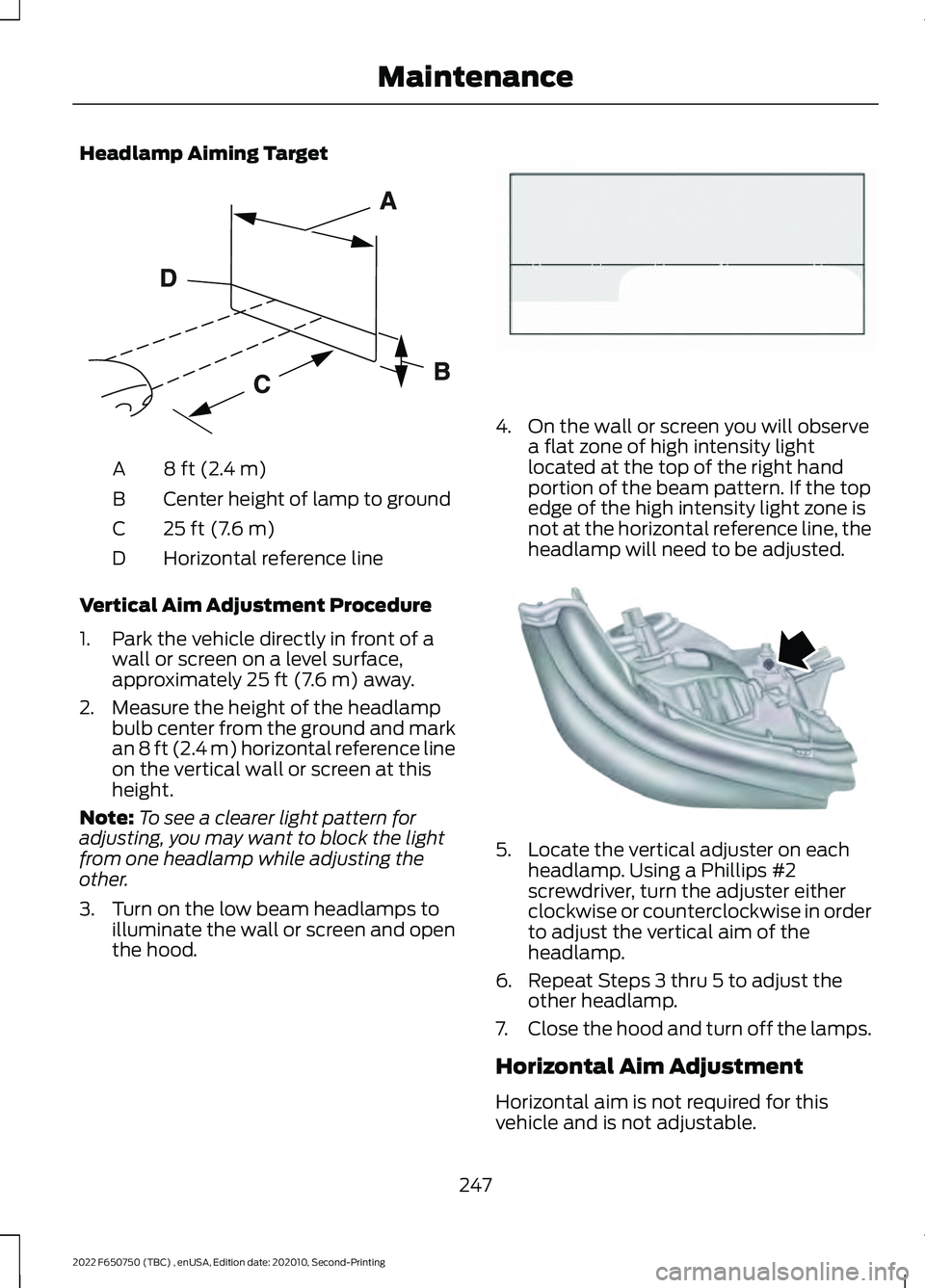
Headlamp Aiming Target
8 ft (2.4 m)
A
Center height of lamp to ground
B
25 ft (7.6 m)
C
Horizontal reference line
D
Vertical Aim Adjustment Procedure
1. Park the vehicle directly in front of a wall or screen on a level surface,
approximately 25 ft (7.6 m) away.
2. Measure the height of the headlamp bulb center from the ground and mark
an
8 ft (2.4 m) horizontal reference line
on the vertical wall or screen at this
height.
Note: To see a clearer light pattern for
adjusting, you may want to block the light
from one headlamp while adjusting the
other.
3. Turn on the low beam headlamps to illuminate the wall or screen and open
the hood. 4. On the wall or screen you will observe
a flat zone of high intensity light
located at the top of the right hand
portion of the beam pattern. If the top
edge of the high intensity light zone is
not at the horizontal reference line, the
headlamp will need to be adjusted. 5. Locate the vertical adjuster on each
headlamp. Using a Phillips #2
screwdriver, turn the adjuster either
clockwise or counterclockwise in order
to adjust the vertical aim of the
headlamp.
6. Repeat Steps 3 thru 5 to adjust the other headlamp.
7. Close the hood and turn off the lamps.
Horizontal Aim Adjustment
Horizontal aim is not required for this
vehicle and is not adjustable.
247
2022 F650750 (TBC) , enUSA, Edition date: 202010, Second-Printing MaintenanceE142592 E142465 E163806
Page 252 of 379
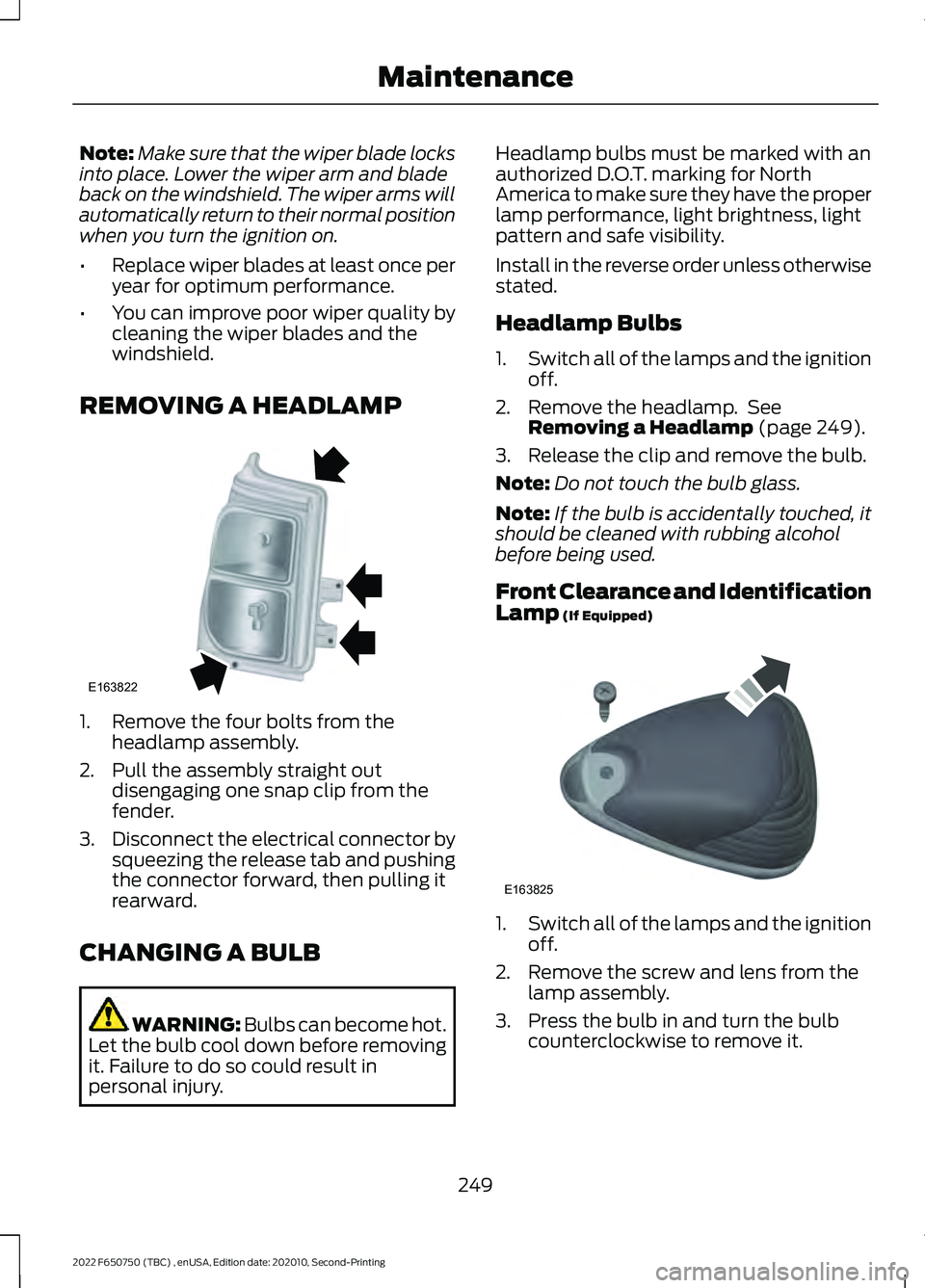
Note:
Make sure that the wiper blade locks
into place. Lower the wiper arm and blade
back on the windshield. The wiper arms will
automatically return to their normal position
when you turn the ignition on.
• Replace wiper blades at least once per
year for optimum performance.
• You can improve poor wiper quality by
cleaning the wiper blades and the
windshield.
REMOVING A HEADLAMP 1. Remove the four bolts from the
headlamp assembly.
2. Pull the assembly straight out disengaging one snap clip from the
fender.
3. Disconnect the electrical connector by
squeezing the release tab and pushing
the connector forward, then pulling it
rearward.
CHANGING A BULB WARNING: Bulbs can become hot.
Let the bulb cool down before removing
it. Failure to do so could result in
personal injury. Headlamp bulbs must be marked with an
authorized D.O.T. marking for North
America to make sure they have the proper
lamp performance, light brightness, light
pattern and safe visibility.
Install in the reverse order unless otherwise
stated.
Headlamp Bulbs
1.
Switch all of the lamps and the ignition
off.
2. Remove the headlamp. See Removing a Headlamp (page 249).
3. Release the clip and remove the bulb.
Note: Do not touch the bulb glass.
Note: If the bulb is accidentally touched, it
should be cleaned with rubbing alcohol
before being used.
Front Clearance and Identification
Lamp
(If Equipped) 1.
Switch all of the lamps and the ignition
off.
2. Remove the screw and lens from the lamp assembly.
3. Press the bulb in and turn the bulb counterclockwise to remove it.
249
2022 F650750 (TBC) , enUSA, Edition date: 202010, Second-Printing MaintenanceE163822 E163825
Page 293 of 379
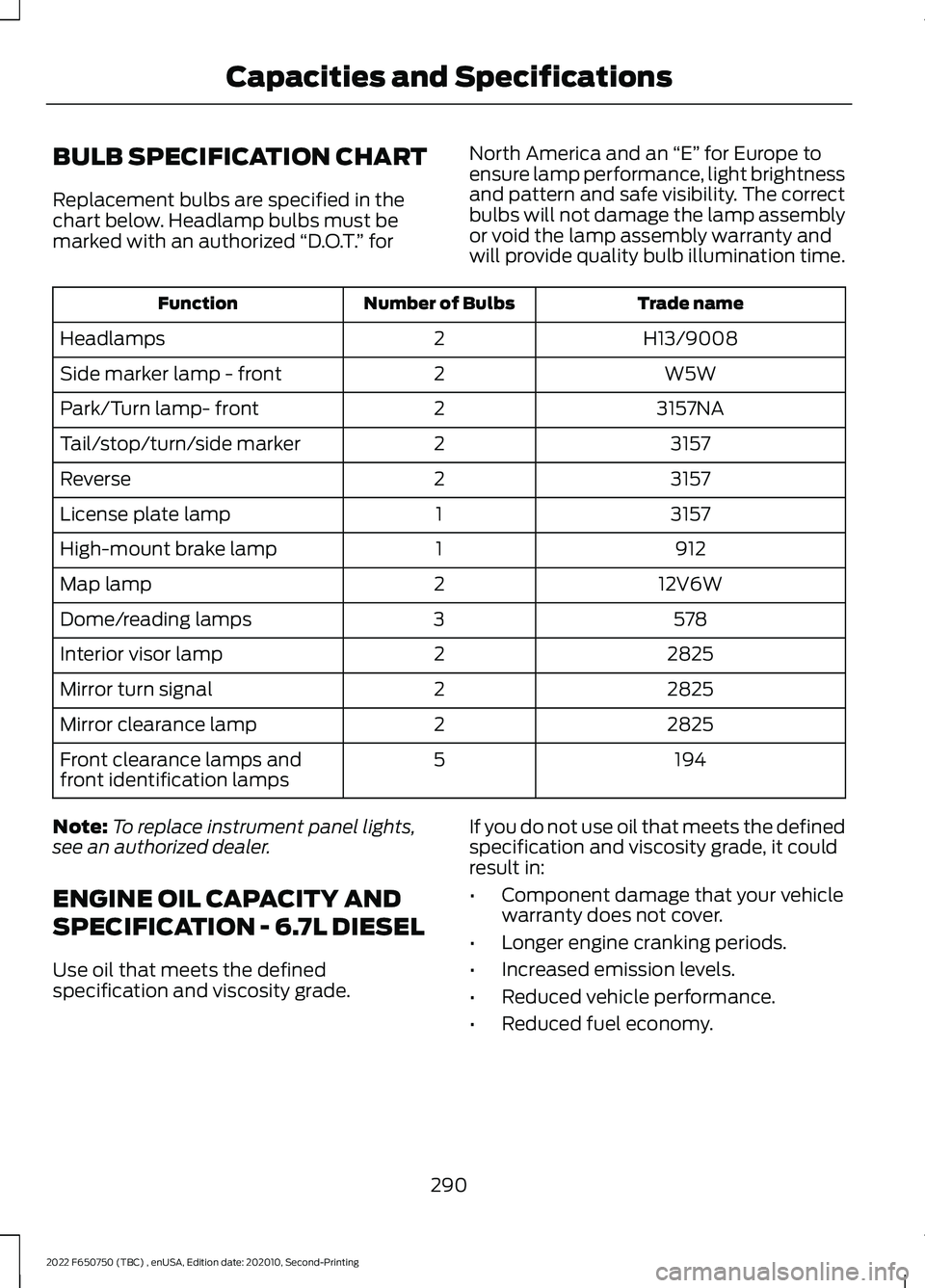
BULB SPECIFICATION CHART
Replacement bulbs are specified in the
chart below. Headlamp bulbs must be
marked with an authorized
“D.O.T.” for North America and an
“E” for Europe to
ensure lamp performance, light brightness
and pattern and safe visibility. The correct
bulbs will not damage the lamp assembly
or void the lamp assembly warranty and
will provide quality bulb illumination time. Trade name
Number of Bulbs
Function
H13/9008
2
Headlamps
W5W
2
Side marker lamp - front
3157NA
2
Park/Turn lamp- front
3157
2
Tail/stop/turn/side marker
3157
2
Reverse
3157
1
License plate lamp
912
1
High-mount brake lamp
12V6W
2
Map lamp
578
3
Dome/reading lamps
2825
2
Interior visor lamp
2825
2
Mirror turn signal
2825
2
Mirror clearance lamp
194
5
Front clearance lamps and
front identification lamps
Note: To replace instrument panel lights,
see an authorized dealer.
ENGINE OIL CAPACITY AND
SPECIFICATION - 6.7L DIESEL
Use oil that meets the defined
specification and viscosity grade. If you do not use oil that meets the defined
specification and viscosity grade, it could
result in:
•
Component damage that your vehicle
warranty does not cover.
• Longer engine cranking periods.
• Increased emission levels.
• Reduced vehicle performance.
• Reduced fuel economy.
290
2022 F650750 (TBC) , enUSA, Edition date: 202010, Second-Printing Capacities and Specifications
Page 374 of 379
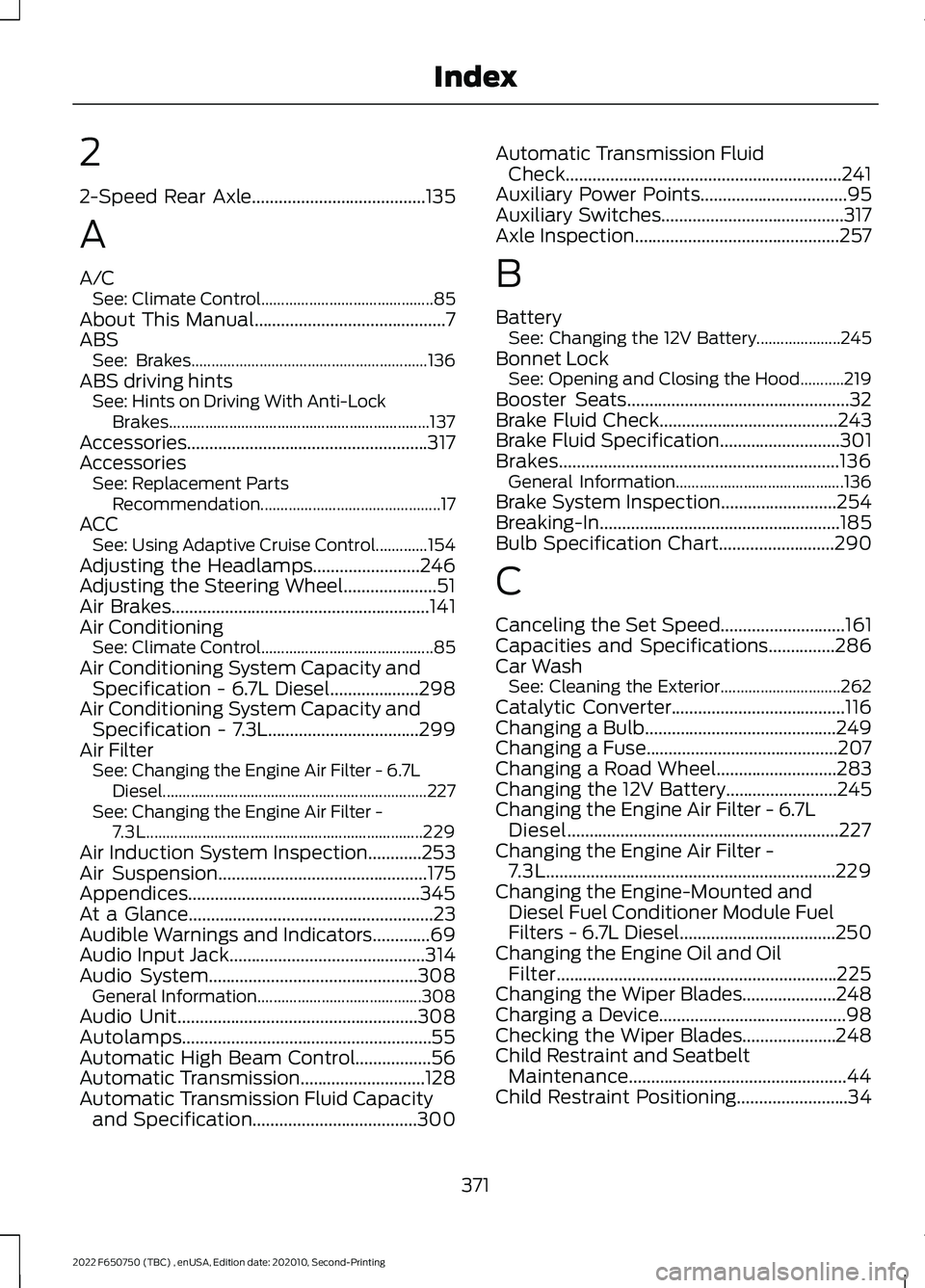
2
2-Speed Rear Axle.......................................135
A
A/C See: Climate Control........................................... 85
About This Manual
...........................................7
ABS See: Brakes........................................................... 136
ABS driving hints See: Hints on Driving With Anti-Lock
Brakes................................................................. 137
Accessories......................................................317
Accessories See: Replacement Parts
Recommendation............................................. 17
ACC See: Using Adaptive Cruise Control.............154
Adjusting the Headlamps........................246
Adjusting the Steering Wheel.....................51
Air Brakes
..........................................................141
Air Conditioning See: Climate Control........................................... 85
Air Conditioning System Capacity and Specification - 6.7L Diesel
....................298
Air Conditioning System Capacity and Specification - 7.3L..................................299
Air Filter See: Changing the Engine Air Filter - 6.7L
Diesel.................................................................. 227
See: Changing the Engine Air Filter - 7.3L..................................................................... 229
Air Induction System Inspection............253
Air Suspension
...............................................175
Appendices....................................................345
At a Glance
.......................................................23
Audible Warnings and Indicators.............69
Audio Input Jack............................................314
Audio System...............................................308 General Information......................................... 308
Audio Unit
......................................................308
Autolamps........................................................55
Automatic High Beam Control.................56
Automatic Transmission
............................128
Automatic Transmission Fluid Capacity and Specification
.....................................300 Automatic Transmission Fluid
Check
..............................................................241
Auxiliary Power Points.................................95
Auxiliary Switches.........................................317
Axle Inspection..............................................257
B
Battery See: Changing the 12V Battery..................... 245
Bonnet Lock See: Opening and Closing the Hood...........219
Booster Seats
..................................................32
Brake Fluid Check........................................243
Brake Fluid Specification...........................301
Brakes...............................................................136 General Information.......................................... 136
Brake System Inspection
..........................254
Breaking-In......................................................185
Bulb Specification Chart
..........................290
C
Canceling the Set Speed
............................161
Capacities and Specifications...............286
Car Wash See: Cleaning the Exterior.............................. 262
Catalytic Converter
.......................................116
Changing a Bulb...........................................249
Changing a Fuse...........................................207
Changing a Road Wheel
...........................283
Changing the 12V Battery.........................245
Changing the Engine Air Filter - 6.7L Diesel.............................................................227
Changing the Engine Air Filter - 7.3L.................................................................229
Changing the Engine-Mounted and Diesel Fuel Conditioner Module Fuel
Filters - 6.7L Diesel...................................250
Changing the Engine Oil and Oil Filter...............................................................225
Changing the Wiper Blades
.....................248
Charging a Device..........................................98
Checking the Wiper Blades.....................248
Child Restraint and Seatbelt Maintenance.................................................44
Child Restraint Positioning
.........................34
371
2022 F650750 (TBC) , enUSA, Edition date: 202010, Second-Printing Index
Page 376 of 379
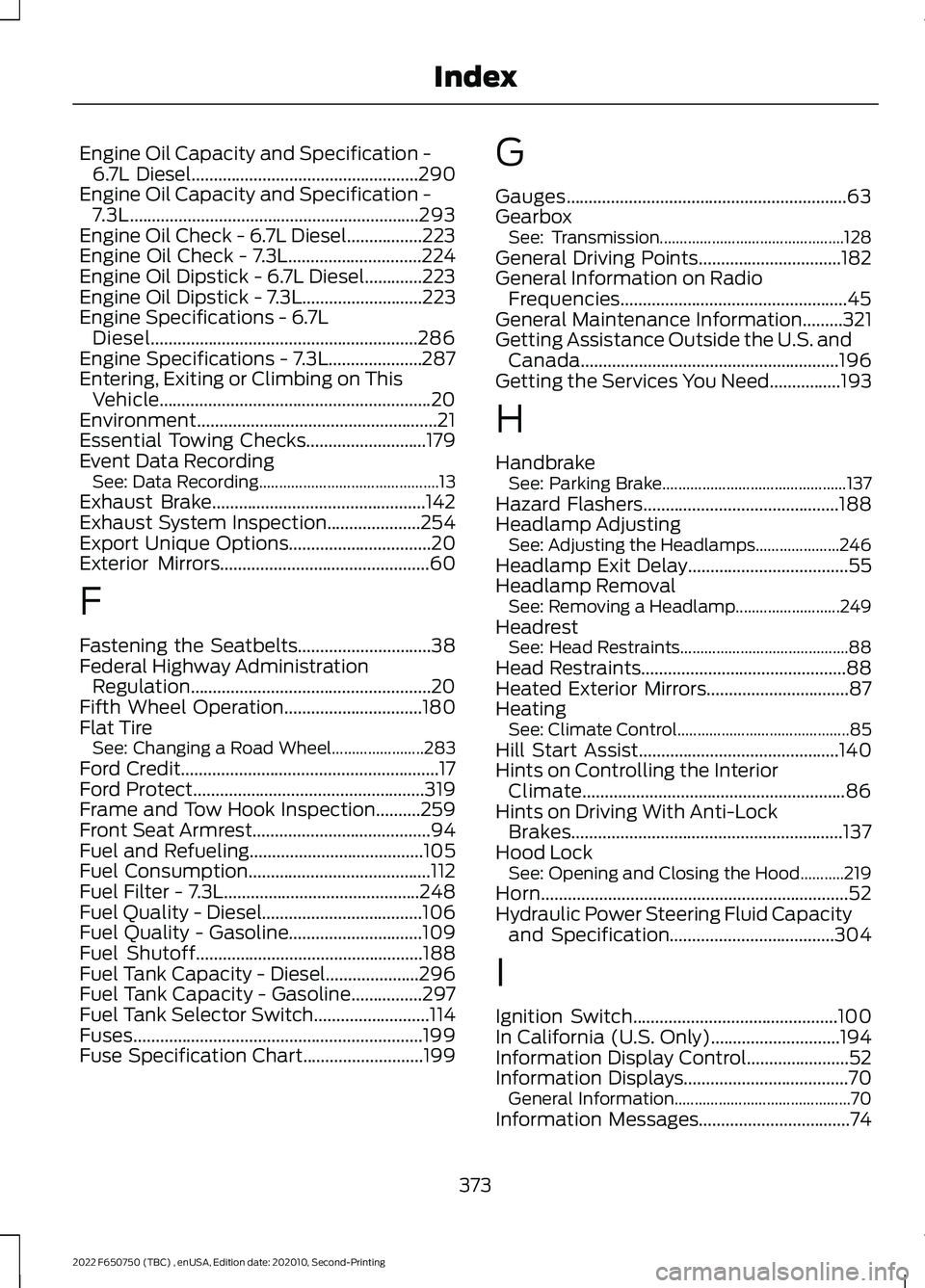
Engine Oil Capacity and Specification -
6.7L Diesel...................................................290
Engine Oil Capacity and Specification - 7.3L.................................................................293
Engine Oil Check - 6.7L Diesel.................223
Engine Oil Check - 7.3L..............................224
Engine Oil Dipstick - 6.7L Diesel.............223
Engine Oil Dipstick - 7.3L...........................223
Engine Specifications - 6.7L Diesel............................................................286
Engine Specifications - 7.3L.....................287
Entering, Exiting or Climbing on This Vehicle
.............................................................20
Environment......................................................21
Essential Towing Checks
...........................179
Event Data Recording See: Data Recording............................................. 13
Exhaust Brake................................................142
Exhaust System Inspection.....................254
Export Unique Options................................20
Exterior Mirrors...............................................60
F
Fastening the Seatbelts..............................38
Federal Highway Administration Regulation......................................................20
Fifth Wheel Operation...............................180
Flat Tire See: Changing a Road Wheel....................... 283
Ford Credit
..........................................................17
Ford Protect....................................................319
Frame and Tow Hook Inspection..........259
Front Seat Armrest........................................94
Fuel and Refueling.......................................105
Fuel Consumption.........................................112
Fuel Filter - 7.3L
............................................248
Fuel Quality - Diesel....................................106
Fuel Quality - Gasoline..............................109
Fuel Shutoff
...................................................188
Fuel Tank Capacity - Diesel.....................296
Fuel Tank Capacity - Gasoline................297
Fuel Tank Selector Switch..........................114
Fuses.................................................................199
Fuse Specification Chart...........................199 G
Gauges...............................................................63
Gearbox
See: Transmission.............................................. 128
General Driving Points
................................182
General Information on Radio Frequencies...................................................45
General Maintenance Information
.........321
Getting Assistance Outside the U.S. and Canada..........................................................196
Getting the Services You Need................193
H
Handbrake See: Parking Brake.............................................. 137
Hazard Flashers
............................................188
Headlamp Adjusting See: Adjusting the Headlamps..................... 246
Headlamp Exit Delay....................................55
Headlamp Removal See: Removing a Headlamp.......................... 249
Headrest See: Head Restraints.......................................... 88
Head Restraints
..............................................88
Heated Exterior Mirrors................................87
Heating See: Climate Control........................................... 85
Hill Start Assist.............................................140
Hints on Controlling the Interior Climate
...........................................................86
Hints on Driving With Anti-Lock Brakes.............................................................137
Hood Lock See: Opening and Closing the Hood...........219
Horn
.....................................................................52
Hydraulic Power Steering Fluid Capacity and Specification.....................................304
I
Ignition Switch
..............................................100
In California (U.S. Only).............................194
Information Display Control.......................52
Information Displays
.....................................70
General Information............................................ 70
Information Messages..................................74
373
2022 F650750 (TBC) , enUSA, Edition date: 202010, Second-Printing Index
Page 378 of 379

Recommended Towing Weights.............178
Refueling - Diesel..........................................110
Refueling - Gasoline......................................111
Remote Control..............................................46
Removing a Headlamp..............................249
Repairing Minor Paint Damage..............265
Replacement Parts Recommendation .........................................
17
Replacing a Lost Key or Remote Control.............................................................47
Reporting Safety Defects (Canada Only)..............................................................198
Reporting Safety Defects (U.S. Only)...............................................................197
Resuming the Set Speed............................161
Roadside Assistance...................................187
Roadside Emergencies
...............................187
Rollover Warning.........................................340
Running-In See: Breaking-In.................................................. 185
Running Out of Fuel - Diesel.....................110
Running Out of Fuel - Gasoline
................110
S
Safety Precautions
......................................105
Scheduled Maintenance............................321
Seatbelt Extensions......................................44
Seatbelt Height Adjustment.......................41
Seatbelt Reminder.........................................42
Seatbelts............................................................37 Principle of Operation......................................... 37
Seatbelt Warning Lamp and Indicator Chime...............................................................42
Seats
...................................................................88
Security..............................................................50
Selective Catalytic Reductant System - Diesel...............................................................118
Setting the Cruise Control Speed..........160
Sitting in the Correct Position...................88
Snow Chains See: Using Snow Chains................................. 283
Spare Wheel See: Changing a Road Wheel....................... 283
Special Notices
................................................18
Special Operating Conditions Scheduled Maintenance................................................331 Speed Control
See: Cruise Control - Vehicles With: Adaptive
Cruise Control................................................. 154
See: Cruise Control - Vehicles With: Cruise Control............................................................... 160
Spring U-Bolt Check...................................259
Stability Control
............................................150
Principle of Operation - Vehicles With: Air
Brakes.................................................................. 151
Principle of Operation - Vehicles With: Hydraulic Brakes............................................ 150
Starter Switch See: Ignition Switch.......................................... 100
Starting a Diesel Engine.............................102
Starting a Gasoline Engine........................101
Starting and Stopping the Engine.........100 General Information......................................... 100
Steering............................................................166
Steering System Inspection....................258
Steering Wheel
.................................................51
Storage Compartments..............................99
Streaming Bluetooth Audio......................314
Sun Visors
.........................................................62
Suspension System Inspection..............258
Switching Cruise Control On and Off...................................................................160
Switching Off the Engine..........................103
Symbols Glossary
...........................................10
T
Technical Specifications See: Capacities and Specifications............286
The Better Business Bureau (BBB) Auto Line Program (U.S. Only).......................195
Tire Care
..........................................................268
Tires See: Wheels and Tires..................................... 268
Towing a Trailer..............................................177
Towing Points
.................................................192
Towing...............................................................177
Traction Control
............................................148
Principle of Operation....................................... 148
Trailer Brakes
..................................................144
Transmission..................................................128
Transporting the Vehicle.............................191
375
2022 F650750 (TBC) , enUSA, Edition date: 202010, Second-Printing Index